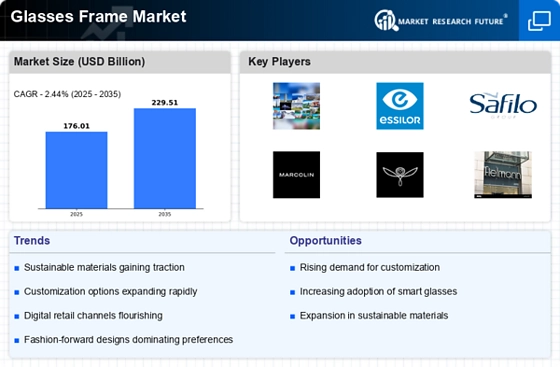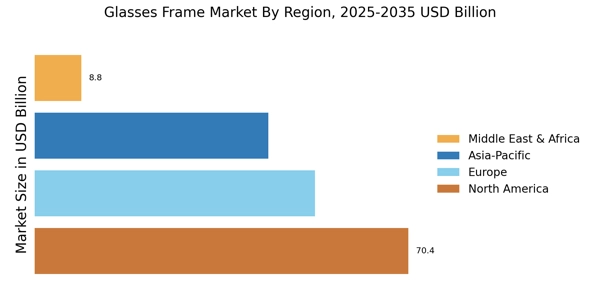Rising Eyewear Fashion Trends
The increasing emphasis on fashion and personal style is a notable driver in the Glasses Frame Market. Consumers are increasingly viewing eyewear not merely as a functional item but as a fashion accessory. This shift has led to a surge in demand for stylish and trendy frames. According to recent data, the eyewear market is projected to reach a valuation of approximately 200 billion by 2025, with a significant portion attributed to fashionable glasses frames. Retailers are responding by offering a diverse range of designs, colors, and materials, catering to various consumer preferences. This trend is likely to continue, as younger demographics, particularly millennials and Gen Z, prioritize aesthetics alongside functionality in their eyewear choices.
Growing Awareness of Eye Health
There is a rising awareness regarding eye health and the importance of regular eye examinations, which serves as a significant driver in the Glasses Frame Market. Educational campaigns and initiatives by health organizations are emphasizing the need for proper vision care, leading to increased consumer engagement. As individuals become more conscious of their eye health, the demand for prescription glasses and fashionable frames is likely to rise. Data suggests that The Glasses Frame Market is expected to grow at a compound annual growth rate of around 8% over the next few years, with a substantial portion attributed to the increasing focus on eye health. This trend is expected to encourage consumers to invest in quality eyewear, thereby boosting the glasses frame segment.
Technological Advancements in Eyewear
Technological innovations are reshaping the Glasses Frame Market, offering consumers enhanced functionality and improved user experience. The integration of smart technology into eyewear, such as augmented reality and health-monitoring features, is gaining traction. For instance, smart glasses equipped with sensors can track health metrics, while augmented reality frames provide interactive experiences. This trend is expected to attract tech-savvy consumers and younger generations, potentially expanding the market. Furthermore, advancements in materials science are leading to the development of lighter, more durable frames, which appeal to a broader audience. As technology continues to evolve, the glasses frame market is likely to witness increased investment and innovation.
E-commerce Growth and Online Retailing
The expansion of e-commerce platforms is transforming the Glasses Frame Market, providing consumers with unprecedented access to a wide variety of eyewear options. Online retailing allows for greater convenience, enabling consumers to browse and purchase frames from the comfort of their homes. This shift has been accelerated by advancements in technology, such as virtual try-on features that enhance the online shopping experience. Data indicates that online sales of eyewear are projected to account for a significant share of the market, with estimates suggesting that e-commerce could represent over 30% of total eyewear sales by 2025. As more consumers turn to online platforms for their eyewear needs, the demand for diverse and stylish glasses frames is likely to increase.
Aging Population and Vision Correction Needs
The growing aging population is a critical factor influencing the Glasses Frame Market. As individuals age, the prevalence of vision-related issues such as presbyopia and cataracts increases, necessitating corrective eyewear. Data indicates that by 2030, the number of individuals aged 60 and above is expected to reach 1.4 billion, significantly impacting the demand for glasses frames. This demographic shift is prompting manufacturers to innovate and design frames that cater specifically to older consumers, focusing on comfort, durability, and style. The need for vision correction among the elderly is likely to drive sustained growth in the glasses frame segment, as more individuals seek solutions to enhance their quality of life.


















Leave a Comment